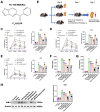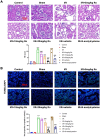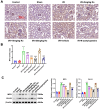Suppression of nF-κB by ro 106-9920 alleviates ischemia/reperfusion-induced renal dysfunction and inflammation via modulation of neutrophil extracellular trap formation in acute kidney injury mice
- PMID: 40796802
- PMCID: PMC12344707
- DOI: 10.1080/0886022X.2025.2545983
Suppression of nF-κB by ro 106-9920 alleviates ischemia/reperfusion-induced renal dysfunction and inflammation via modulation of neutrophil extracellular trap formation in acute kidney injury mice
Abstract
Neutrophil extracellular trap (NET) formation has been proven to take part in the exacerbation of acute kidney injury (AKI). Ro 106-9920, an effective inhibitor of nuclear factor kappa B (NF-κB) signal, could abrogate the formation of NETs. Herein, we explored whether Ro 106-9920 (Ro) exerts a protective role in AKI by repressing NET formation. The AKI model was induced with 30 min-bilateral renal ischemia followed by reperfusion. After finishing the 7-day treatment of Ro or vehicle, blood and the kidney were collected from each mouse for further analysis. Enzyme-linked immunosorbent assay, H&E, and TUNEL staining, immunohistochemistry, as well as Western blot were carried out to observe the kidney function, renal damage, apoptosis, and inflammation, and to preliminarily uncover the underlying mechanism. Administration with Ro effectively protected against AKI in a dose-dependent manner, as proven by the reduction of serum creatinine, serum neutrophil gelatinase-associated lipocalin, blood urea nitrogen, and serum inflammatory cytokine in AKI models after its administration. Moreover, Ro significantly alleviated morphological damage, kidney cells apoptosis, as well as inflammatory cytokine secretion in renal tissues. Mechanically, phosphorylation of NF-κB and myeloperoxidase activity were observed in renal tissues of AKI models, which suggested NF-κB activation and NETosis occurred in AKI. Notably, Ro treatment could significantly repress the nuclear translocation of NF-κB and the increased myeloperoxidase activity. Ro has a protective potential on ischemia/reperfusion-induced AKI by attenuating apoptosis and inflammation, perhaps by suppressing NF-κB activation and is associated with reduced NETosis.
Keywords: Acute kidney injury; Ro 106-9920; ischemia/reperfusion injury; neutrophil extracellular trap formation; nuclear factor kappa B.
Conflict of interest statement
No potential conflict of interest was reported by the author(s).
Figures





Similar articles
-
Obtusifolin inhibits podocyte apoptosis by inactivating NF-κB signaling in acute kidney injury.Cytotechnology. 2024 Oct;76(5):559-569. doi: 10.1007/s10616-024-00638-x. Epub 2024 Jun 21. Cytotechnology. 2024. PMID: 39188647
-
TAG-FREE GLYCOSYLATED RHMFG-E8 AS A THERAPY FOR ACUTE KIDNEY INJURY.Shock. 2024 Aug 1;62(2):286-293. doi: 10.1097/SHK.0000000000002382. Epub 2024 Apr 30. Shock. 2024. PMID: 38691106
-
The degree of aortic occlusion in the setting of trauma alters the extent of acute kidney injury associated with mitochondrial preservation.Am J Physiol Renal Physiol. 2024 Apr 1;326(4):F669-F679. doi: 10.1152/ajprenal.00323.2023. Epub 2024 Mar 7. Am J Physiol Renal Physiol. 2024. PMID: 38450433 Clinical Trial.
-
Management of urinary stones by experts in stone disease (ESD 2025).Arch Ital Urol Androl. 2025 Jun 30;97(2):14085. doi: 10.4081/aiua.2025.14085. Epub 2025 Jun 30. Arch Ital Urol Androl. 2025. PMID: 40583613 Review.
-
Hydroxyethyl starch (HES) versus other fluid therapies: effects on kidney function.Cochrane Database Syst Rev. 2013 Jul 23;2013(7):CD007594. doi: 10.1002/14651858.CD007594.pub3. Cochrane Database Syst Rev. 2013. PMID: 23881659 Free PMC article.
References
LinkOut - more resources
Full Text Sources
Research Materials
